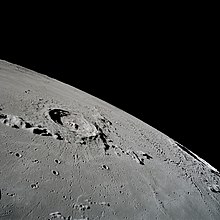
Copernicus is a lunar impact crater located in eastern Oceanus Procellarum. It was named after the astronomer Nicolaus Copernicus. It typifies craters that formed during the Copernican period in that it has a prominent ray system. It may have been created by debris from the breakup of the parent body of asteroid 495 Eulalia 800 million years ago.

Arzachel is a relatively young lunar impact crater located in the highlands in the south-central part of the visible Moon, close to the zero meridian. It lies to the south of the crater Alphonsus, and together with Ptolemaeus further north the three form a prominent line of craters to the east of Mare Nubium. The smaller Alpetragius lies to the northwest, and Thebit is to the southwest along the edge of the mare.

Aristoteles is a lunar impact crater that lies near the southern edge of the Mare Frigoris and to the east of the Montes Alpes mountain range. It was officially named in 1935 after the ancient Greek philosopher Aristotle by the International Astronomical Union, using the classical form of his name.
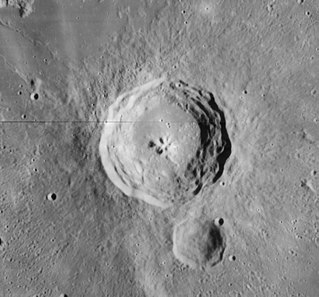
Bullialdus is a lunar impact crater located in the western part of the Mare Nubium. It was named after French astronomer Ismaël Boulliau. To the north by north-west is the broken-rimmed and lava-flooded crater Lubiniezky. South-west of Bullialdus lies the smaller crater König.

Ptolemaeus is an ancient lunar impact crater close to the center of the near side, named for Claudius Ptolemy, the Greco-Roman writer, mathematician, astronomer, geographer and astrologer. It measures approximately 154 kilometers in diameter.
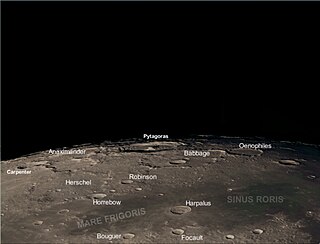
Pythagoras is a prominent impact crater located near the northwestern limb of the Moon. It lies just to the northwest of the somewhat larger Babbage. The crater has an oval appearance due to the oblique viewing angle. Only the western face of the interior can be viewed from the Earth, the other side being permanently out of sight.
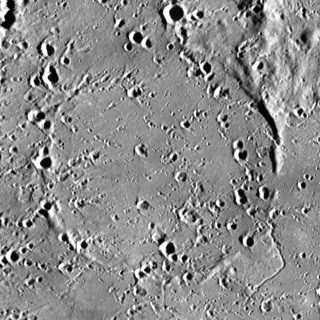
Stadius is a ghostly remnant of an ancient lunar impact crater that has been nearly obliterated by basaltic lava flows. It was named after Flemish astronomer Johannes Stadius. It lies to the southwest of the much younger crater Eratosthenes, at the north edge of Mare Insularum where the mare joins Sinus Aestuum. To the west is the prominent ray crater Copernicus, and multiple secondary craters from the Copernican ejecta cover this area. To the northwest is a chain of craters that continue in a roughly linear formation until reaching Mare Imbrium.

Wallace is the remains of a lunar impact crater that has been flooded by lava. It was named after British natural historian Alfred Russel Wallace. It lies in the southeastern part of Mare Imbrium, to the northeast of the crater Eratosthenes. The crater rim forms a somewhat polygonal outline, and is broken in the southeast. The floor is flat and devoid of significant features, but it is overlain by ray material from Copernicus to the southwest. The rim ascends to an altitude of 0.4 km above the lunar mare.

Hipparchus is the degraded remnant of a lunar impact crater. It was named after the Greek astronomer, geographer and mathematician Hipparchus. It is located to the southeast of Sinus Medii, near the center of the visible Moon. To the south is the prominent crater Albategnius, and to the southwest lies Ptolemaeus, a feature of comparable dimensions to Hipparchus. Horrocks lies entirely within the northeast rim of the crater. Halley is attached to the south rim, and Hind lies to the southeast. To the north-northeast is the bowl-shaped Pickering, and the flooded Saunder is located off the northeast rim. High-resolution images of Hipparchus were obtained by Lunar Orbiter 5 in 1967.

Petavius is a large lunar impact crater located to the southeast of the Mare Fecunditatis, near the southeastern lunar limb. Attached to the northwest rim is the smaller crater Wrottesley. To the southeast are Palitzsch, Vallis Palitzsch, and Hase. Farther to the north is the large crater Vendelinus. Petavius appears oblong when viewed from the Earth due to foreshortening. Petavius is Imbrian in age.

Fauth is a small double-crater located at the edge of the rough southern ramparts of the prominent ray crater Copernicus on the Moon. It lies in the Mare Insularum, to the northeast of the crater Reinhold. The crater is named after German selenographer Philipp Johann Heinrich Fauth.

Arago is a lunar impact crater located in the western part of the Mare Tranquillitatis. It was named after French astronomer François Arago in 1935. Its diameter is 26 km. To the southwest lies the crater Manners, and beyond are Dionysius and the Ritter–Sabine crater pair. To the southeast is the large Lamont formation that has been submerged by the mare.
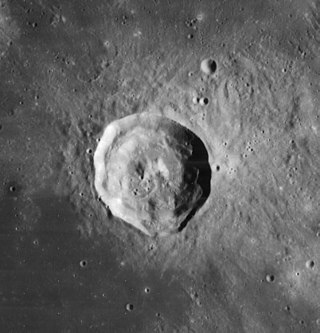
Manilius is a lunar impact crater on the northeast edge of Mare Vaporum. Its diameter is 38 km.

Pytheas is a small lunar impact crater located on the southern part of the Mare Imbrium, to the south of the crater Lambert. It was named after ancient Greek navigator and geographer Pytheas of Massalia.

Reinhold is a prominent lunar impact crater that lies to the south-southwest of the crater Copernicus, on the Mare Insularum. It was named after 16th century German astronomer and mathematician Erasmus Reinhold. To the southwest is the slightly smaller crater Lansberg.

Godin is a lunar impact crater located just to the south of the crater Agrippa, on a rough upland region to the east of Sinus Medii. Its diameter is 34 km. The crater was named after 18th century French astronomer Louis Godin. The ruined crater Tempel lies to the northeast, on the east side of Agrippa. Due south is the flooded remains of Lade.

Lassell is a small lunar impact crater that is located in the eastern part of the Mare Nubium. It was named after British astronomer William Lassell. It lies to the west of the crater Alpetragius and southwest of Alphonsus.

Ukert is a lunar impact crater that lies on a strip of rugged ground between Mare Vaporum to the north and Sinus Medii in the south. It was named after German historian Friedrich August Ukert. It is located to the north-northwest of the crater Triesnecker and northeast of the crater pair of Pallas and Murchison.

Cayley is a small lunar impact crater that is located in a lava-flooded region to the west of Mare Tranquillitatis. It was named after the 19th-century English mathematician Arthur Cayley. It lies to the northwest of the smaller crater De Morgan and the larger D'Arrest. West and slightly north of Cayley is Whewell, a crater of about the same dimensions. To the north is a linear rille designated Rima Ariadaeus, which follows a course to the east-southeast.

The Lunar X is a clair-obscur effect in which light and shadow creates the appearance of a letter 'X' on the rim of the Blanchinus, La Caille and Purbach craters.

